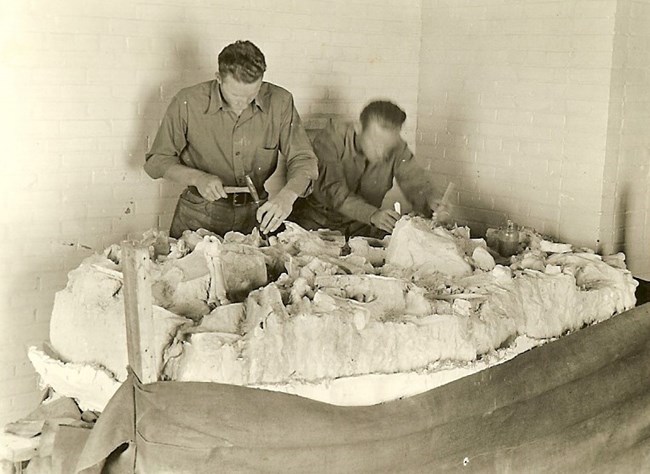Last updated: December 11, 2025
Article
Paleontology at Scotts Bluff National Monument

NPS
What is Paleontology?
Paleontology is the study of ancient life forms; both plants and animals. Paleontologists learn about past life by studying fossils. The badlands formations in northern section of Scotts Bluff National Monument contain some of the richest fossil-bearing strata in the state of Nebraska. Most of the fossils found in the monument are vertebate mammal and reptile fossils. These fossils serve as type, or indicator, fossils for the Oligocene Epoch (23.0 to 33.9 million years ago).
NPS from the Marvel Moore Collection
A Brief History of Paleontology in Western Nebraska
The area surrounding Scotts Bluff has long been recognized as an excellent location for finding fossils. Native peoples were undoubtedly the first to collect and study fossils in Nebraska as people from many Plains tribes, including the Arapaho, Cheyenne, Pawnee, and Sioux, are known to have collected fossils. U.S. Army Scout, Captain James H. Cook wrote in Sketches of the Life of Red Cloud of a visit to Red Cloud Agency in the 1870s where he was shown a fossilized tooth by Lakota Chief American Horse. Later, fur traders took notice of the fossils found in the area. In 1847 a fur trader showed the jawbone of a Titanothere (a herbivorous, odd-toed hoofed mammal that lived during the Eocene between about 50 and 34 million years ago) to Dr. Hiram Prout of St. Louis. When emigrants began to travel past Scotts Bluff on their ways to Oregon, California, and the Salt Lake Valley, some, like William Clayton, recorded fossil discoveries in their journals.
"We saw about a mile this side of the foot of the bluffs a very large bone almost petrified into stone. Most of the brethren believed it to be the shoulder bone of a mammoth, and it is very large indeed." -Mormon Pioneer William Clayton in 1847
Systematic, paleontological exploration of the Scotts Bluff area really started in 1874 when M.H. Clifford and A.S. Shelly started collecting paleontological specimens from western Nebraska for O.C. Marsh of Yale University. Yale University's Peabody Museum includes 138 objects from the White River Group at Scotts Bluff. Paleontology continued in the monument in the 1930s. Workers of the Civil Works Administration (CWA) discovered fossils of carnivorans, rhinoceroses, oreodonts, and deer-like animals when they excavated the three road tunnels to the summit of the bluff. Enrollees of the Civilian Conservation Corps (CCC) conducted fossil excavations in the monument's badlands. Even today, scientists from universities throughout the United States visit Scotts Bluff to study the rich paleontological resources found here.

NPS
Fossil Resources Found at Scotts Bluff National Monument
The oldest exposed rocks in the monument are found in the badlands formations along the North Platte River. Known as the Brule Formation, these rocks contain rich assemblages of fossils. Among the most commonly found fossils in these rocks are those of oreodonts. Oreodonts were herbivorous, even-toed mammals. They lived from the Middle Eocene into the late Miocene (from 40 million to 5 million years ago.) Their existence here implies that the environment of Scotts Bluff National Monument was once open savannah for grazing, interrupted by braided river channels. Not much different from the monument we know today.
NPS/Eric Grunwald
